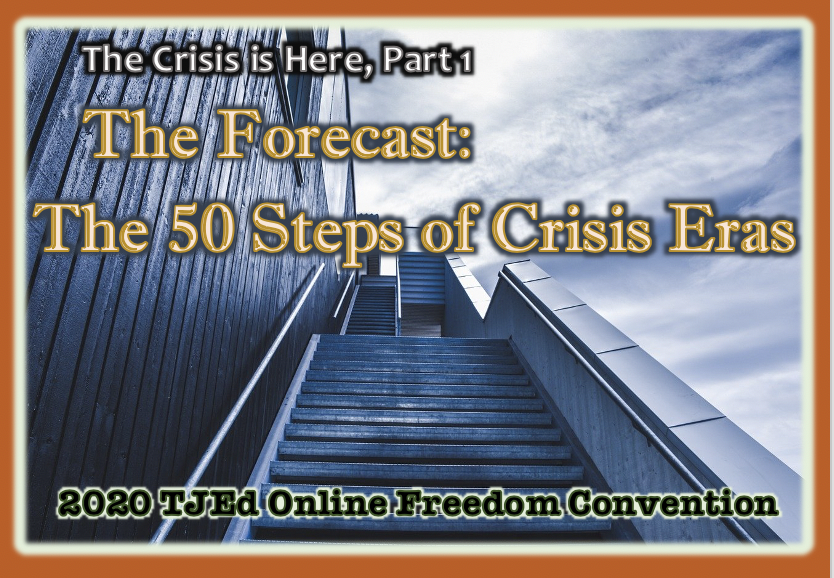The 5 Best Books I Read in 2024 By Oliver DeMille
December 19th, 2024 // 5:06 am @ Oliver DeMille
They are all worth reading. In fact, it was very difficult to narrow it down to just 5. With that said, here they are, along with some thoughts on why each one is great, and tips on things to look for as you go. If any of them pique your interest, get them and read… Enjoy the list!
- Insidious by Orrin Woodward. This book is fantastic! A must read, and a runaway for the #1 top book of the year. In fact, it’s so great that I wrote an entire article and review just to talk about the super-important ideas in this one book.
| Tip: Go read my article about this book here. |
- Government Gangsters by Kash Patel. It’s deep, spot on, and incredibly relevant to our world today. Patel outlines what needs to happen to get our government back, specifically to size it down wisely and make it follow the Constitution once again. And he tells us what to do as well as the specifics of how to do it. Great book! Fabulous read, whether you agree with his recommendations or not.
| Tip: Pay special attention to everything he says about “fencing”. This alone is worth the price of the book. And after you study this, also research the word “impoundment” as it relates to the Federal Government. So important. Indeed, Fencing and Impoundment may be as important in our time as Checks and Balances were in the time of the American Framers. Not that they should be, but you want to know what they are and how they are used. |
- Jane Austen’s Little Book of Wisdom compiled by Andrea Kirk Assaf. This small book is pure fun! Every quote is worth deeply pondering. You’ll truly benefit from the witty and profound wisdom it contains. I loved it. Whether you want to be a better leader, spouse, dad, mom, student, sibling, boss, or employee, or just improve yourself and your effectiveness in relationships and life, this book is great reading on two levels—the wisdom of the words, and the beauty of how Austen uses the language. It will put a little more poetry and charm into your personality! Or just bring more smiles to your face in the year ahead. Super fun.
| Tip: Read and ponder one quote each day. At this pace it will last almost a year—and the year will undoubtedly be better! |
Continue Reading >>
Category : Blog &Book Reviews &Citizenship &Community &Culture &Current Events &Economics &Education &Featured &Generations &Government &History &Independents &Information Age &Leadership &Liberty &Politics &Postmodernism &Producers &Prosperity &Statesmanship &Technology
The 2020 TJEd Online Convention is getting Rave Reviews!
April 6th, 2020 // 1:13 pm @ Oliver DeMille

Here’s what people are saying!
Many thanks to your whole family for all you do!
~ Jennifer Halverson
Watch the video trailer!
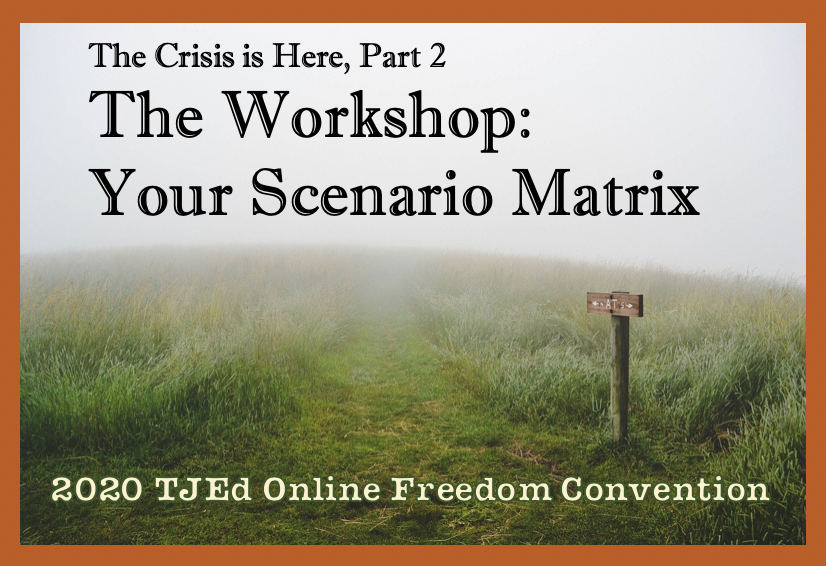 Listened to these talks in the convention today…I am speechless! I had chills the whole time I was listening! I’m excited to go back and do the planning section. Amazing how my perspective has changed so quickly. Going to have my husband listen, too. Thank you so much for this amazing resource!!!
Listened to these talks in the convention today…I am speechless! I had chills the whole time I was listening! I’m excited to go back and do the planning section. Amazing how my perspective has changed so quickly. Going to have my husband listen, too. Thank you so much for this amazing resource!!!
UPDATE: I just now worked through part of the matrix exercise. Wow, how powerful!
~ Rachael Breneman
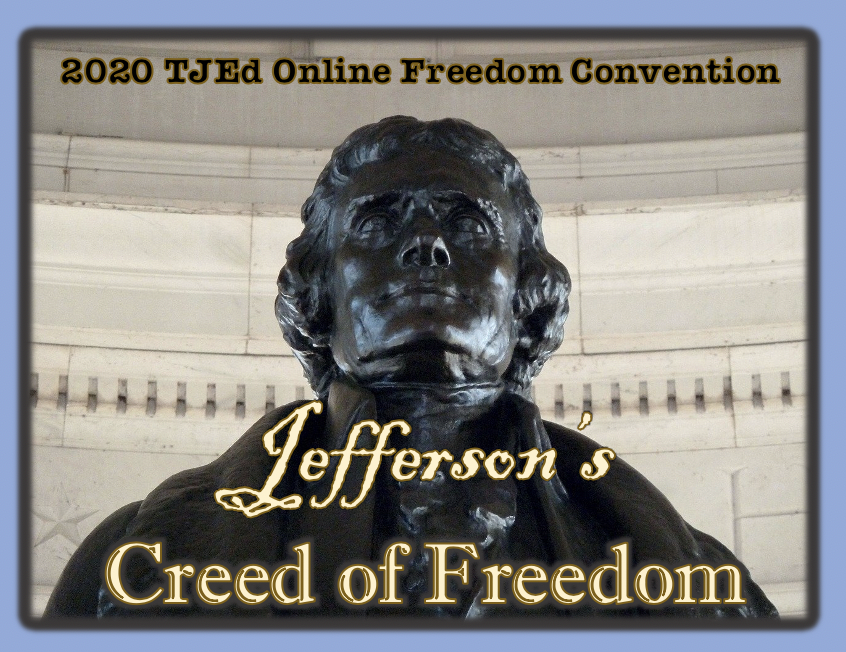 I just want to say thank you to you both. You have sacrificed so much for your mission and so many of us and our children have been blessed because of your sacrifice! I listened to The Crisis is Here part 2 from the 2020 Freedom convention today. On top of the wonderful exercise Oliver led and the incredible insight, I was also struck with how grateful I am that I have been so prepared for this moment.
I just want to say thank you to you both. You have sacrificed so much for your mission and so many of us and our children have been blessed because of your sacrifice! I listened to The Crisis is Here part 2 from the 2020 Freedom convention today. On top of the wonderful exercise Oliver led and the incredible insight, I was also struck with how grateful I am that I have been so prepared for this moment.
It is thanks in a large part to being mentored through TJEd that I have the family culture, understanding of turnings and history, life centered at home, classics on our shelves that teach us human nature, an appreciation for seasons and cycles and the confidence and ability to teach my family. While these times are uncertain, I don’t feel afraid or overly anxious. I’m actually looking forward to the next few decades and what “spring” will bring. I’m excited for my children and I to be a part of it!
~ Amy Updike
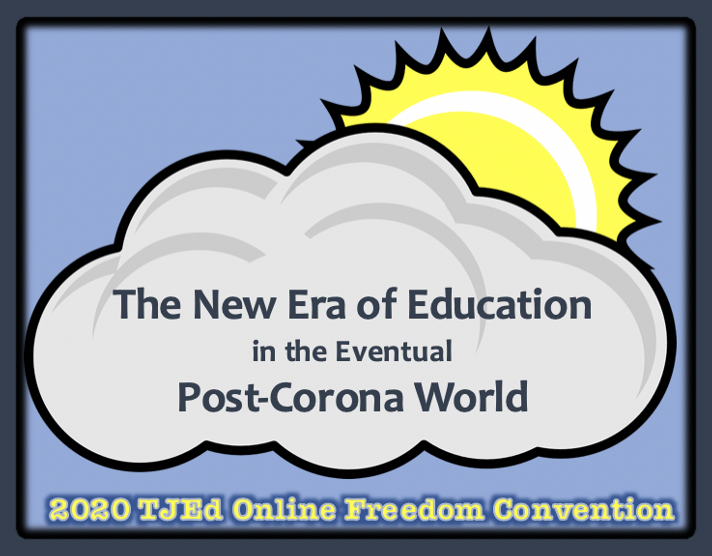 Before any of us realized what happened, the world changed, and it is very likely that for better or worse, nothing will be the same again.
Before any of us realized what happened, the world changed, and it is very likely that for better or worse, nothing will be the same again.
Now what?
I have learned a great deal from Oliver DeMille. The talks he has given already in this convention have really changed the way I am looking at what is happening right now, and he is just getting started.
If you want to know what to do to adapt to our new reality, I’d recommend signing up for this convention!
~ Colby Lyons
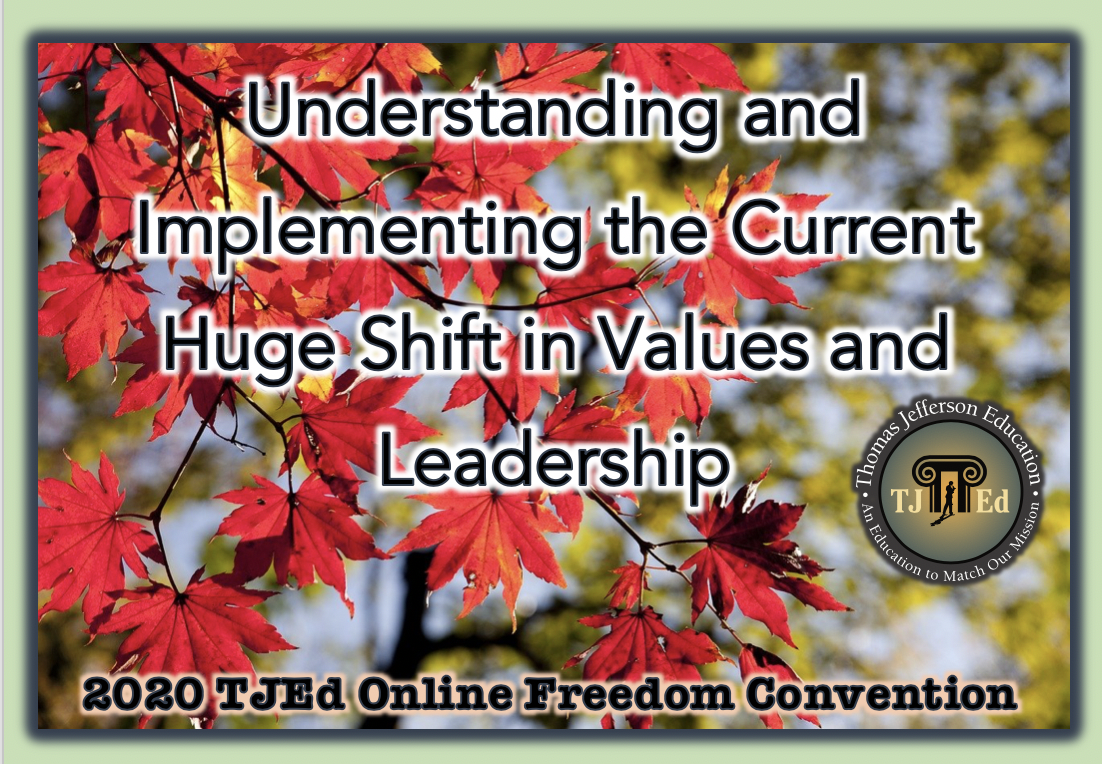 Oliver and Rachel, THANK YOU so much for this year’s convention! We just listened to the 2nd workshop and are so excited for this time in history!
Oliver and Rachel, THANK YOU so much for this year’s convention! We just listened to the 2nd workshop and are so excited for this time in history!
We’ve handled the crisis well because of our faith but this really got us pumped for our future!
My daughter, who is a senior, has struggled a little because she felt so uncertain of her immediate future.
Now, she’s happy and at peace that she is already on the right path to get through this crisis well. She loved the workshops so far! Can’t wait for the rest!
~ Kellee Clark
Watch the video trailer!
Join us for the 2020 Freedom Convention Here!
Special thanks to Lyle Mast of OR Sports for his contribution of 100 family scholarships!
And TJEd is matching that sponsorship to cover an additional 100 families!
If you need this assistance in order to participate in the convention, PLEASE don’t hesitate to request it; that’s exactly what it’s for, and we don’t want you to miss out!
Just click here to inquire and we’ll get you taken care of.
Category : Aristocracy &Blog &Business &Citizenship &Constitution &Culture &Current Events &Economics &Education &Entrepreneurship &event &Family &Featured &Generations &Government &History &Independents &Information Age &Leadership &Liberty &Mini-Factories &Mission &Politics &Producers &Prosperity &Statesmanship &Tribes
THE JEFFERSON-MADISON DEBATES: Can the Constitution Survive?
July 17th, 2019 // 8:20 am @ Oliver DeMille
PART I
 European “Conservatism” and American “Conservatism” are not the same thing.[i] It’s important to realize that “conservatism,” in the generic, isn’t defined as a specific platform or set of ideals. It’s simply the posture and priority of “conserving” a certain tradition or form, as opposed to “liberal–ly“ or “progressive-ly” moving away from said tradition or form.
European “Conservatism” and American “Conservatism” are not the same thing.[i] It’s important to realize that “conservatism,” in the generic, isn’t defined as a specific platform or set of ideals. It’s simply the posture and priority of “conserving” a certain tradition or form, as opposed to “liberal–ly“ or “progressive-ly” moving away from said tradition or form.
As George Will has pointed out, in Europe “Conservatism” was rooted in protecting monarchy, aristocracy, and the class system (where the many are ruled by the few), while in America “Conservatism” means protecting and maintaining the U.S. Constitution and the principles upon which it was framed, including the key principles articulated in the Declaration of Independence.[ii] Indeed the Declaration itself initiated the end of European Conservatism in America.[iii]
The tug-of-war between American Conservatism and Progressivism has been part of the American story ever since.[iv] Progressivism has gone through several stages–all of them a direct and escalating attack on the Constitution:
Step 1- Statism: Increase the size and scope of the government
Step 2- Centralized Statism: Increase the size and scope of the federal government
Step 3- Liberalism: Use the increasing size and scope of the federal government to redistribute money from the affluent to the lower classes by state force
Step 4- Socialism: Use the increasing size and scope of the federal government to redistribute money from the affluent and middle classes to the lower classes by state force, putting control of the federal government in the hands of a few, and also mandate social and environmental causes that require the federal government to grow even more
Step 5- Globalized Socialism: Expand progressive goals to include federal government programs for people around the globe (not limited to American citizens), requiring a massive expansion of government size and scope and progressive transfers of power and sovereignty from the American voters (and voters within other nations) to international organizations, agreements, and entities
We are currently in the High-Growth Phase of Step 4 and the Early-Growth Phase of Step 5.
PART II

American Conservatism, in contrast, focuses on implementing the U.S. Constitution, a return to Constitutional limited government (to the extent that we’ve moved away from the Constitution), and a citizenry that rules itself rather than being ruled by a class of elites.[v] Today the battle between Conservatism and Progressivism is in full swing.
To measure which side is ahead in this contest, the scoreboard is a simple two-question matrix:
- Is the size, scope, debt, and expenditure of the federal government shrinking?
If “Yes,” Conservatism is winning.
- Is the size, scope, debt, and expenditure of the federal government expanding?
If “Yes,” Progressivism is winning.
This is the only real indicator of direction, momentum, and victory. Every other possible marker can be faked or obscured. What this scoreboard shows is that the following administrations in the modern era have increased American Progressivism (thus decreasing Conservatism/Adherence to the U.S. Constitution):
- Roosevelt
- Truman
- Eisenhower
- Kennedy
- Johnson
- Nixon
- Ford
- Carter
- Reagan
- Bush
- Clinton
- Bush
- Obama
- Trump
In contrast, the following administrations reduced the scope, size and expenditure of the Federal Government, increasing American Conservatism and adherence to the U.S. Constitution:
NONE
This comes as a surprise to many conservatives. Indeed, this reality makes it clear which approach is winning: Progressivism. But surely some of the more conservative administrations at least significantly slowed down the increasing scope, size and expenditure of government, right?
The following administrations significantly slowed these things down:
NONE
This must have been caused by the opposing liberal Congress faced by certain administrations, right? The following administrations attempted to significantly slow the increase of the Federal Government’s size, scope, and expenditure, but were thwarted by the Congress:
NONE
At first glance, for conservatives at least, this doesn’t seem to make sense. Clearly there is a big difference between some of the administrations, that of Carter and Reagan for example, or Obama and Trump. While this is true, the actual differences are not what most people tend to think.
Where the genuine application of Conservative principles often results in significant benefits to the nation, the overall trend since 1944 can only be characterized as firmly escalating in the direction of Progressivism. The nation has occasionally profited from a short-term implementation of Conservative principles (e.g. Eisenhower, Reagan, Trump), but this has not resulted in a reversal of the Progressive trend.
Moreover, during this entire timeline, Progressive momentum has accelerated. It has never reversed. Conservatism (protection and application of the U.S. Constitution and Constitutional limits) has given way to Progressivism (the expansion of the welfare state and the size/scope of the central government) during every administration in the post-World War II era.
A more accurate understanding of these trends is possible if we consider the dominant Steps of Progressivism implemented in modern American history. This allows us to more clearly rate the Conservatism vs. Progressivism of each administration:
Dominant Focus of Washington D.C. from 1860-1913
Step 1- Statism: Increase the size and scope of the government
Dominant Focus of Washington D.C. from 1913-1944
Step 2- Centralized Statism: Increase the size and scope of the federal government
Dominant Focus During the Truman, Kennedy, and Clinton administrations
Step 3- Liberalism: Use the increasing size and scope of the federal government to redistribute money from the affluent to the lower classes by state force
Dominant Focus During the Eisenhower, Nixon, Ford, Reagan, Bush, Bush, and Trump administrations
Step 2- Centralized Statism: Increase the size and scope of the federal government
Dominant Focus During the Roosevelt, Johnson, and Obama administrations
Step 4- Socialism: Use the increasing size and scope of the federal government to redistribute money from the affluent and middle classes to the lower classes by state force, putting control of the federal government in the hands of a few, and also mandate social and environmental causes that require the federal government to grow even more
Dominant Focus of the Current Left since 2016
Step 5- Globalized Socialism: Expand Progressive goals to include federal government programs for people around the globe (not limited to American citizens), requiring another massive expansion of government size and scope and progressive transfers of power and sovereignty from the American voters (and people within other nations) to international organizations and entities
PART III

There are at least three significant considerations in all of this that every American needs to understand:
- None of the presidential administrations in the post-World War II era have implemented Conservatism (the genuine application of Constitutional limits). All have supported the Progressive agenda at some level (increase of the size and scope of the federal government beyond its Constitutional boundaries, including an expansion of the welfare state). Some administrations promoted this more than others. But all are complicit in Progressivism, while none adhered to Conservatism as defined above (the Application of all Constitutional Limits, versus Increasing the Scope, Size, and Expenditure of Government).
- Presidents considered by many to be the most “Conservative” (including Eisenhower, Reagan, Trump) promoted Step 2 Progressivism but not Step 3 Progressivism. Specifically, they actively increased the size and scope of the federal government, but didn’t drastically increase redistribution of money/programs from the affluent to the lower classes by state force. This led to economic upturn through deregulation—a good result. It did not, however, reverse the momentum of the welfare state or reinvigorate Constitutional limits; as a consequence, the trend toward bigger government and increased Progressivism continues unabated.
- Presidents widely considered the most Progressive (Roosevelt, Johnson, Obama) implemented Step 4 Progressivism (socialism: major redistribution from the upper and middle classes to government programs nominally for the poor and disadvantaged) and drastically increased the growth rate of the long-term Progressive trend. This always coincided with major (albeit medium-length) economic downturn.
There has been no genuinely Conservative presidential administration (one focused on maintaining the limited size and scope of government to the specific limitations of the Constitution) since presidents Harding and Coolidge in the 1920s. All administrations since that time have promoted an expansion of the federal government in size, scope, and expenditure. The growing welfare state (Progressivism) has continually won out over Constitutional limits (Conservatism).
This has been aided by a number of decisions in the Court expanding the scope of the federal government and naming many additional federal powers “constitutional”. Ironically, such decisions are, according to the original words of the Constitution, unconstitutional.[vi]
PART IV
Why?
Why have all administrations since the mid-1920s joined the Progressive trend, even while many have loudly proclaimed their “bona fide Conservatism”? The answer may be as simple as that suggested by George Will[vii]: Most Americans actually like a lot of our government programs. And today we want more of them, not less. We want programs for “other people” to be cut or discontinued, but we tend to cling to government programs that directly benefit us.

Irony is at work here. On the one hand, voters seem to want freedom—but within limits. Specifically, they want more freedom for themselves than for others. And they want government programs—also within limits. The masses want something that has never been a reality—the quality levels attained by private schools, private institutions of higher education, private health care, and private-sector prestige jobs, provided free to all by government, and paid for by “the rich”–“the 1 Percent”.
Another way to describe our situation is that Progressivism has largely won the battle for the hearts and minds of most Americans. The Conservative ethos—that government should protect our freedoms by adhering to the U.S. Constitution, and give us nothing else, nothing at all, because the rest is up to us alone, our individual hard work, tenacity, initiative, ingenuity and good choices—is now largely a foreign concept.[viii] It is as quaint in our cities, and beyond, as vinyl records or public payphones. We want government to do things for us—lots of things. “How else will it get done?” most Americans now ask.
A majority of Americans now want to work less, make more, and receive a lot of extra government benefits paid for by someone else. If that’s what it means now to be an American, then America is on the path to major decline.[ix] And perhaps the most shocking point: Almost nobody is arguing about this.
We argue about whether or not such government benefits should go to illegal aliens. Some say “Yes, of course. Be generous”, while others respond “No way! Don’t make me pay for their needs. What about Americans, what about our needs?” But both sides miss the deeper issue. Again, most Americans now want to work less, get paid more, and receive a lot of extra government programs paid for by someone else. As long as this is our agreed-upon worldview, we’re in decline, and sinking fast.
We have, on one side, those who want more government benefits for everyone. Another side wants fewer government programs/expenditures for those who aren’t Americans.
But where are those who refuse all benefits that the government offers to them, preferring freedom? —the citizens who want to stand on their own, to make their own way without government help, who want to actually be free? Where are those kind of Americans today?
Without them, American-style Conservatism is extinct. Without them, Progressivism has won.
Most modern Americans want independence without having to select the choices that make them independent. “With all the taxes I pay, I’m not going to turn down government benefits.” The problem is, at its root, that government forces us to pay for the welfare state, whether we accept any of its benefits or not. For most people, as a result, rejecting the benefits appears illogical, even stupid. And they’re right.
But can the Constitution survive such a populace? If the masses want to work less, make more, and refuse to reject government benefits, the government will continue to grow. Limited constitutionalism is already over, in such a world.
Prediction: Unless this changes, we will only elect those promising the easy path, and we will vote ourselves consistently into decline. The Republican Party will oscillate between Progressive Steps 2 and 3, while the Democrat Party will swing back and forth between Progressive Steps 4 and 5. Regardless of which side wins elections, the federal government will keep expanding. Freedom will be redefined, redirected, and reduced, and eventually it will disappear, following the long-established pattern of great power nations.[x]
There is, of course, a solution. It is called limited government. It is outlined in the United States Constitution.
First: the federal government must be held to the twenty powers (only 20!) outlined in Article I Section 8 of the U.S. Constitution.
Second: the Executive branch and its agencies must be required (by the voters, and all those they elect) to actually follow the Constitution. Third: the Court must also be required to follow the Constitution (by the voters, and all those they elect), without dodging this duty by claiming that it can simply redefine the document whenever it wants.
The voters have all the power to make these three things happen.
We have the blueprint. It will work, if the voters demand it.
But it will only work if the voters demand it.
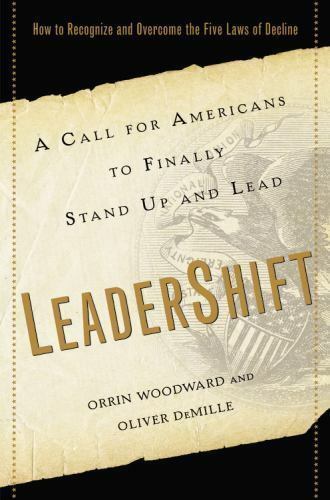 *How can we get regular citizens to be this kind of voter? The answer is outlined in the book LeaderShift: A Call for Americans to Finally Stand Up and Lead, by Orrin Woodward and Oliver DeMille. In LeaderShift you’ll learn the 5 Laws of Declining Nations, why America is currently failing all 5 Laws, and what to actually do about it. Find out how to get America back on track for the long term!
*How can we get regular citizens to be this kind of voter? The answer is outlined in the book LeaderShift: A Call for Americans to Finally Stand Up and Lead, by Orrin Woodward and Oliver DeMille. In LeaderShift you’ll learn the 5 Laws of Declining Nations, why America is currently failing all 5 Laws, and what to actually do about it. Find out how to get America back on track for the long term!
NOTES
[i] See George Will, 2019, The Conservative Sensibility
[iii] See Russell Kirk, 1974, The Roots of American Order
[iv] See Arthur Schlesinger, 1986, The Cycles of American History
[v] See op cit., Kirk; see also W. Cleon Skousen, 1985, The Making of America
[vi] The Constitution of the United States, Article III; see also Madison, Hamilton, Jay, 1989, The Federalist, Papers 78, 80, 83
[vii] See op cit., Will
[viii] See Oliver DeMille, 2014, The U.S Constitution and the 196 Indispensable Principles of Freedom
[ix] See Orrin Woodward, 2014, And Justice for All; see also Jonah Goldberg, 2018, Suicide of the West; see also Thomas Sowell, 2007, A Conflict of Visions
[x] See Paul Kennedy, 1987, The Rise and Fall of the Great Powers
Category : Aristocracy &Blog &Citizenship &Community &Constitution &Culture &Current Events &Economics &Featured &Foreign Affairs &Generations &Government &History &Independents &Information Age &Leadership &Liberty &Politics &Prosperity &Statesmanship
THE JEFFERSON-MADISON DEBATES: A New Cold War is Coming PART II
June 11th, 2019 // 7:41 am @ Oliver DeMille
What Americans Can Do To Effectively Protect American Freedoms in the Decades Just Ahead
(Book Review of American, by Shanon Brooks)
Note to reader: read Part I of this report here >>
I. The Challenge
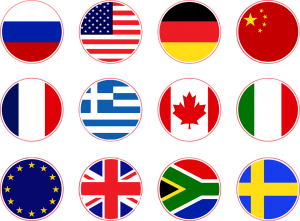
The 21st Century is shaping up as an era of major conflict, between (1) the three superpowers (the U.S., Russia, and China) and their allies and proxies (the European Union, Israel, North Korea, Iran, etc.), and also between (2) the Red- and Blue-state cultures that are further dividing America. If the U.S. doesn’t fix the problem (2) above, it will almost certainly lose the first battle (1) to China and/or Russia.
But what can regular Americans actually do? What will really work?
The three most effective things Americans can do to maintain our freedoms, families, and leadership in an increasingly dangerous world are:
- Spread great, classics- and freedom-based, leadership education
- Engage entrepreneurialism, the key to free enterprise, and encourage/help others to do the same
- Vote correctly and influence other voters to do the same (to protect and increase freedoms), and effectively influence government between elections
The battle for world leadership will come down to how well Americans do these three things. If we don’t win this battle, the world by 2040 will likely be run by two superpowers: China and Russia. Freedom values will be at odds with the rest of the world, and greatly reduced in the United States. Socialism will be the norm from the California redwoods to the beaches of Florida, from the Midwest to the Plains, and from the Rockies to Maine, in the cities and farms, and across all fifty states. Many of our most cherished freedoms will be reduced, or stolen.
How can we ensure that this doesn’t happen? A new book addresses this very question. This may be one of the most important books of our time; if we read and understand it, and take the right action, the future of America, our freedoms, our economy and our families, will be bright. If we don’t take the needed action…freedoms will be lost, socialism will spread, and families will suffer.
The book is titled simply, and sagely, American.
II. The Journey
Indeed, the title says it all. Written by Shanon Brooks, American gets to the heart of the problem, and the solutions. As Brooks puts it: “…we are killing the American Dream. Out of the top 30 countries in the world, the U.S. ranks 16th in literacy…and 14th in problem solving.”
Does that sound like a superpower? Or more like a past leader currently in decline? If we’re only 14th in problem solving, how can we truly expect to lead in the decades ahead, to tackle and solve our greatest problems, to help lead the world as it faces and overcomes the challenges ahead?
But the problem is even more daunting. Brooks wrote:
“National unfunded obligations are more than $100 trillion while U.S. household debt is at an all-time high of $13.2 trillion. We have one of the most litigious societies in the world, our incarceration rate is among the highest globally, and our state and federal legislatures are convinced that they are our cradle-to-grave caretakers.”
Unless something changes soon, and in major ways, we are not on the path to increased freedoms or economic opportunities for our children or grandchildren. In fact, we are quickly headed in the opposite direction.
As Brooks notes:
“How can we claim that America is the greatest nation in the world when 60% of our population can’t even pass the U.S. citizenship test? What have we done with the legacy of liberty that the founders so carefully crafted for us? And what are we creating to pass down to our children and grandchildren?”
The problem is real. The divide between those who even care about freedom and those who don’t is quickly expanding. And the root of the problem is at the very core of our daily lives: how we are educated, how we make a living, and how we participate (and don’t participate) as citizens overseeing and governing our own nation. As Travis Slade notes in the preface to American: “Pretty much everything about how we live today is killing the American Dream.” He’s right. And this book, American, is much more than a handbook on the principles of freedom—it’s all about how to apply those principles in the world today, in this economy, given the reality of the world we actually live in. Along the way, it addresses real issues across the board, including:
- Our Decaying Education System
- Our Work Life—Pros and Cons
- The Way People Vote and Otherwise Participate (or don’t) in Overseeing Our Government
- Commercial and Residential Construction
- The Health Care Industry
- The Transportation Industry
- The Food and Grocery Industry
- Local Law Enforcement
- The Issues of Immigration
- The Regulation State versus Free Enterprise
- Socialism versus Investment
- Employee versus Owner Mindsets
- Federal Government Overreach
- …Etc.
American asks us to seriously consider a number of poignant questions, questions that our national school/education system has patently taught us not to ask—or even think about in any meaningful way.
For example: “How can the American Dream be alive when each new American baby…inherits $300,000 of national debt…?”
And “…bureaucracy so deep and stifling that most just give up and give in.”
This book describes an America the Framers wouldn’t even recognize, a nation deeply entrenched in a bureaucratic quagmire the likes of ancient Byzantium, with a few celebrities, wealthy super elites, and top government officials (and their families) enjoying benefits akin to a medieval Venetian aristocracy.
And we call this “American?” It isn’t. It was supposed to be different. It was designed to be different. But only the people are capable of keeping our freedoms, as the Framers warned. No elites will save us. It is up to regular Americans.
III. Solutions
The best part of American is the solutions. I won’t spoil the book by listing them all here, or going into detailed applications and strategies, but they cut right to the heart of the matter, skipping symptoms and focusing on what we really need to do in order to steer things in the right direction. If we want real freedom, and effective results, we’re going to have to act. Brooks outlines what we need to do, and how to get started.
Specifically, as mentioned above, this book emphasizes the three major things we need to influence, change, and improve if America is going to survive as an effective beacon of freedom—in the world, and at home to the rising generations.
First, the right kind of education. Second, the right choices in the way we as a people make a living. And third, the way we vote—what goes into our voting decisions and the way we train up young people to be wise voters—and the ways we actively participate in governing our nation between elections.
Ultimately, these three things boil down to the quality of our learning, the kind of education we share, support, and pass on to our children and especially our young adults. If we get this right, the rest will follow. If not, our freedoms are very much in danger. America simply cannot survive three more generations of education like what we currently have.
We actually have two education systems in modern America, one for elites and those who work as the elites’ advisors, professionals, and managers, and another for the masses. Most Americans attend the second type of schools; the result is that America now educates mostly followers. This hard-to-hear reality is, nonetheless, true. It is time to face it openly, and change it. American is not just a great book on freedom and leadership, but an excellent book on higher education, right up there with Henry Newman’s great classic The Idea of a University, The Higher Learning in America by Robert Hutchins, An Education for Our Time by Josiah Bunting, and The Closing of the American Mind by Allan Bloom. Brooks benefitted from the ideas in all of these, and many others, and as a result American is the best book on higher education that I have ever read.
Every American who cares about freedom and our future should read it. And every American should care about freedom and our future.
Perhaps most importantly, Brooks’ book will introduce the reader to a number of very important ideas and principles that are seldom discussed anymore—in schools, homes, churches, or places of business, and certainly not by the media—but were once understood, cherished, and debated by every free American. The early Americans taught these things to their children, and were ashamed if any of their children couldn’t articulate these principles of freedom and life fluently and in detail. Such principles constitute the bulk of chapters 1 through 10 in American. Knowing them fully, and understanding how to apply them in society, was once considered crucial to being an American. They have now been almost entirely lost, and with them many of our freedoms. To reboot our freedoms, we must understand these vital principles and ideas.
It is time for us to know them. To pour over them, and to master them. To share them, teach them, talk about them, debate them, and apply them. It is past time. We cannot wait any longer. We must act. Again, our freedoms and the future of our posterity are at stake. If we get the freedom principles right, if we understand and effectively implement them, we will be another generation of American heroes. If not, the candle of American freedom will be snuffed out.
This is true. This is real. This is happening.
Not every person will apply the things learned in American the same way. Or even agree on every specific. This is the way it should be—free people applying principles differently, based on personal mission. But all of us should learn them. Know them. Ponder, discuss, and apply them as inspired.
It is time.
To act…
Recommended Reading
- American (Shanon Brooks) 2019—Available on the Monticello College website >>
Category : Aristocracy &Blog &Book Reviews &Business &Citizenship &Community &Constitution &Culture &Current Events &Economics &Education &Entrepreneurship &Family &Featured &Foreign Affairs &Generations &Government &History &Independents &Information Age &Leadership &Liberty &Mini-Factories &Mission &Politics &Prosperity &Statesmanship
Let’s talk presidential election 2020
May 8th, 2019 // 6:30 am @ Oliver DeMille
News of the Day

May 2019:
Let’s talk politics briefly–specifically the 2020 U.S. presidential election. Who is the leading candidate for the Democrats? According to the polls, it’s Joe Biden. But it’s way too early for the polls to get things right, and even if the polls could make an accurate prediction right now, the real answer to this question (“Who is the leading candidate?”) goes much deeper than polls, or even who’s running for office.
The real question, as political insiders understand, is this: “Who is the greatest threat to each party’s candidate?” The answers are significant. In the case of Democrats, the major threat is Donald Trump. This is always true of incumbent presidents, so no surprise here. But in the case of who looms as the biggest threat to president Trump in 2020, the answer is a bit surprising for most people, and certainly for anyone who gets their news from the mainstream media. Again, for insiders the answer is clear. But what is it?
Trump vs. ???
Does Trump’s major threat come from Joe Biden? Or Bernie Sanders? What about Kamala Harris, or Cory Booker, or any other Democrat senator, governor, mayor, representative or billionaire running for office? Or perhaps a serious run by Michele Obama, if she makes the unlikely choice to seek the Oval Office?
Answer: None of these. In fact, Trump’s major threat for the 2020 election comes from a former short-time member of George H.W. Bush’s administration in 1992. As mentioned, this is a surprise. But real. The big threat to Trump winning the election is Jerome Powell. For most Americans, the immediate response is “Jerome who…?”

Powell is the chair of the Federal Reserve, and Fed decisions between now and election day 2020 can almost single-handedly determine whether Donald Trump ends up serving one or two terms. How? Answer: As Bill Clinton advisor James Carville once quipped, “It’s the economy, stupid.”
It’s the Economy, Stupid
The 2016 election pitted strongly-blue states against firmly-red states, but came down to Republican wins in the Rust Belt: Pennsylvania, Michigan, Wisconsin, Indiana, Ohio, and West Virginia. Today these states are experiencing precisely what they voted for in 2016: a booming economy and rising wages, most notably among middle class working voters. If this continues, or even holds steady at current levels (barring major catastrophe of some kind), 2020 is likely a “shoo-in” for Trump/Pence.

If the boom stagnates, or returns to economic decline and “slow growth or no growth as the new normal,” as experienced from 2008-2016, the eventual Democratic nominee will likely sweep the Rust Belt and many-if-not-most of the Purple swing states. That’s the game.
The most significant factors determining economic upswing or downturn, now that the current Administration has drastically reduced the regulatory red tape that hampered business growth during the Bush and Trump eras, are the choices made at the sole discretion of the Federal Reserve. Jerome Powell, not the political parties and not even the media, potentially (if the Fed chooses to put its thumb on the scale) holds the future in his hands.
The Constitutional Question
For me, the real issue here is the following question: “What would the American Framers and Founders say about this arrangement?” Probably the same thing most Americans should be thinking about a lot more:
Why does an institution not even mentioned in the Constitution, and facing only one minor Constitutional balance and no serious Constitutional checks from any of the three branches of the U.S. Government, have this kind of power?
Whatever your politics, why does one organization and its head, virtually unknown to the large majority of Americans, control our future? This is THE question of the 2020 election, but so far I haven’t heard it voiced anywhere.
Category : Blog &Citizenship &Community &Constitution &Current Events &Economics &Featured &Generations &Government &History &Independents &Information Age &Leadership &Liberty &Politics &Prosperity &Statesmanship


